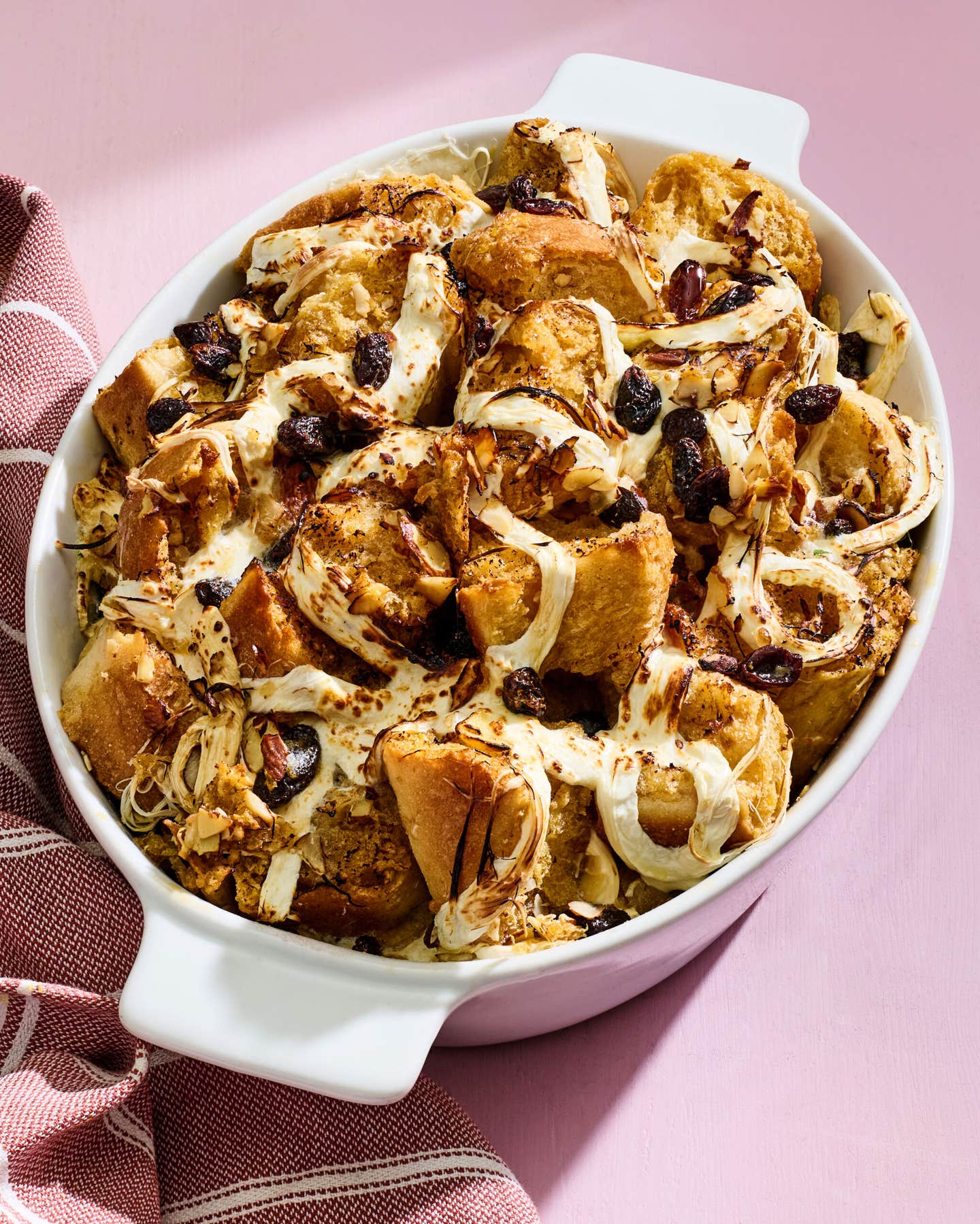
Gumbo Paradise
From the small farms of Cajun Country to the elegant Creole restaurants of New Orleans, Louisiana is home to one of the world’s most versatile comfort foods
As the sun sets on the small Cajun town of Scott, Louisiana, Sheriff Tommy Hebert labors with his young son, Noah, in the backyard garden of a brick farmhouse. The 50-year-old lawman is shirtless, exhibiting the kind of jagged musculature only a person who works the land can attain. He and Noah are gathering okra from a modest row Hebert plants each May and harvests throughout the summer. Using a Smith & Wesson pocketknife, Hebert slices off the end of a woolly pod that seems about a foot long and hands it to me. I've never tried raw okra before; it never occurred to me to do so. But when I bite into it, I decide it's something I'd like to do damn near every day. It's got a snap that leads to a taste reminiscent of fresh-cut grass. Hebert will stew some with tomatoes for dinner; the rest he'll slice up, freeze, and, when the weather cools this autumn, thaw to make a gumbo. According to him, you can't make a good one without it. Most people down here will tell you that okra is the origin of the word gumbo. In her book New Orleans: A Food Biography (AltaMira Press, 2012), historian Elizabeth M. Williams attributes the term “gumbo” to Bantu-speaking West Africans, who brought okra seeds on slave ships. Their word for okra was ki ngombo. Other scholars believe gumbo is a deviation of the Choctaw Indian word kombo, for sassafras leaves, which tribal members ground up to make an aromatic powder called filé. While either okra or filé can be used to thicken gumbo, there are strong opinions as to which is best.
Hebert's wife, Jessica, joins us as we walk beyond the garden to take a look at the marshes farther back. Hebert flooded this land with well water years ago so he could grow rice and raise crawfish. A chicken comes strutting by, and Hebert gazes at it for a second. “I can make a good gumbo out of just about anything in my yard,” he tells me. “It's all right here.”
During the five years I spent living in New Orleans, and the decade that has passed since, this is what I've come to love about gumbo: It is a dish in and of the state of Louisiana: its waters, its smokehouses, its rice mills, and its backyard gardens. It is everything to everybody: It is a transcendent soul food served buffet-style at Li'l Dizzy's Café in New Orleans' Treme neighborhood, or an august Creole delicacy presented by tuxedoed wait staff during Friday lunch at Galatoire's in the French Quarter. It is something enjoyed at family celebrations where Cajun music plays from an old clock radio in the kitchen; or something you mindlessly slurp down while seated drunk on a bar stool listening to an old Irma Thomas song work its magic from the jukebox.
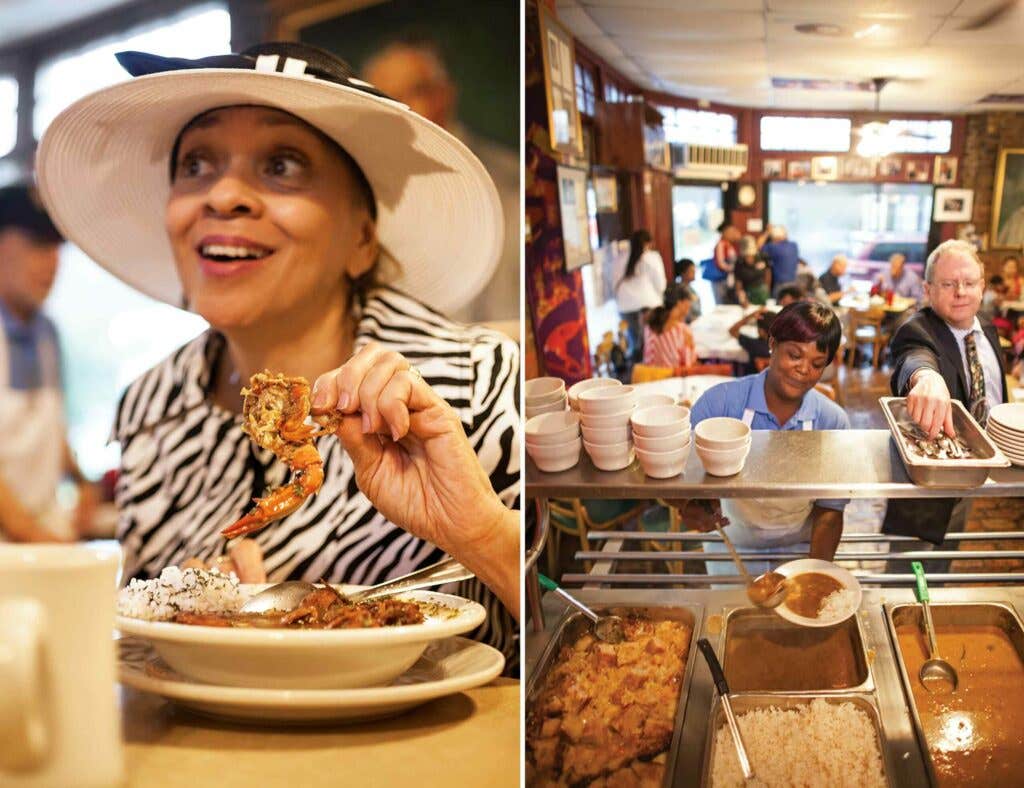
I may have grown up in the suburbs of Cincinnati, but for me, gumbo is a favorite comfort food and a saving grace. The year I made my first was among the most dismal of my life. After more than a dozen years of arguing with my girlfriend over whether we wanted to get married (I did; she didn't) or have kids (same), she moved out of our Brooklyn apartment. A month later, on a cold November morning, my sweet old border collie mix, Gracie, died at the end of my bed.
The kitchen fridge, once filled with farmers' market produce and butcher shop meats, was now blindingly white inside, save for the six-packs and takeout containers. The sink in which my girlfriend and I had rinsed fresh greens and bell peppers was nothing more than a receptacle to ash cigarettes into as my cat, Walker, looked on, wondering if he should move out, too.
One good thing did happen that year. My favorite football team—the once notoriously awful New Orleans Saints—was winning. A lot. And as 2009 mercifully yielded to 2010, they were well on their way to their very first Super Bowl. It was a modest miracle, yes, but one that lifted the spirits of a city and a state still yearning for signs of hope five years after the ravages of Katrina. To join them in celebration, I decided to put my troubles aside and host a Super Bowl party for which I would make my first gumbo. For guidance, I turned to a new cookbook, Donald Link's Real Cajun (Clarkson Potter, 2009) and his recipe for a fried chicken and andouille version.
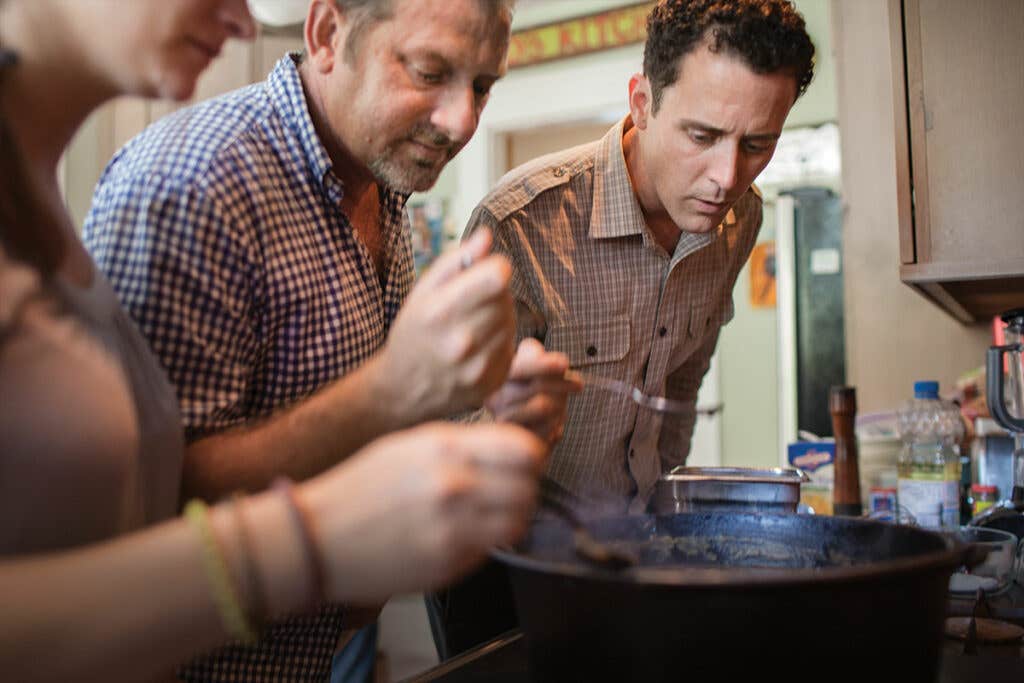
Early that Sunday morning, I fried some chicken in vegetable oil, crisping the skin before removing it. Then I slowly added some flour to begin my roux. Following Link's instructions, I whisked it for 40 minutes, downing a couple of beers in the process. Fifteen minutes in, the roux smelled exactly like it was supposed to: nutty with overtones of burnt popcorn. I added the Louisiana trinity of chopped onion, bell pepper, and celery, as well as a spice mix that included pepper, paprika, and filé powder. Then I transferred the roux to a soup pot and added my chicken broth. A half hour later, I plopped in the fried chicken to continue cooking, and an hour after that, the sliced andouille. Then I anxiously awaited the results.
In the end, I created something extraordinary: a dark, thick, rustic stew with just the right amount of heat, redolent of spicy sausage, fried chicken, and stewed vegetables. As friends started to arrive, I proudly ladled out my day's labor. The Saints won that night. Life, it seemed, was getting better. And Link's gumbo became part of my repertoire.
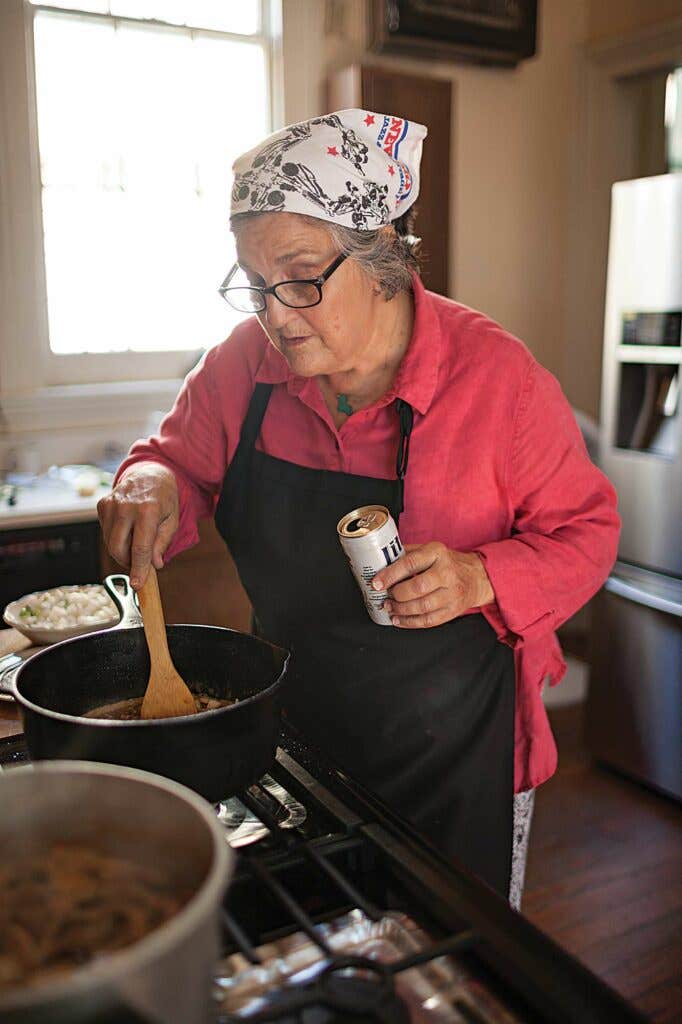
During this recent trip back to Louisiana, however, I am reminded that everyone makes gumbo differently, that Link's is just one of a million variations. It's like Janice Macomber tells me in her daughter's New Orleans kitchen as she stirs what will turn out to be one of the best seafood gumbos I've ever had: "There are as many gumbos in Louisiana as there are mamas." (Everyone has her own gumbo saying, too.)
Today, Janice, who lives in the Cajun town of Abbeville and teaches at The New Orleans Cooking Experience, is making hers using the bounty of Louisiana's waters: blue crabs, shrimp, and some fried oysters she took home as leftovers last night from a restaurant called Shucks. Gumbo, after all, is a mishmash of whatever happens to be available, whether it's freshly caught redfish or leftover oysters, butcher shop sausage or hunted-down fowl.
With a Beau Jocque CD playing in the background, the Cajun grandmother, her thick gray hair tamed beneath a bandana, tears the claws off the crabs before peeling her shrimp and tossing the shells of both into a stockpot filled with water. She pours some oil into a beat-up old skillet, lines up two cold Miller Lites stove-side, and starts her fragrant roux. “I just love that smell,” she tells me. “I had a Cajun friend in Colorado who was dying. She asked me to come and cook a roux in her kitchen—just so she could smell Louisiana.”
Written mentions of gumbo go back centuries, but no one knows when exactly it was born. Many theorize its origins might be the bouillabaisse made by early French settlers in Louisiana. And with Africans laboring in New Orleans' Creole kitchens, it's easy to see how okra made it into the mix, too. As far as roux goes, blond versions are often used as a base for French sauces and vegetable dishes. Some scholars surmise that, one fateful day, a cook might have burned his roux, then added it to the pot anyway, satisfying Louisianians' desire for more intense flavors.
Cajuns—largely French Acadians who were exiled to the bayou in the early 1700s for refusing to swear loyalty to the British crown—were forced to make their gumbos with whatever ingredients they could muster, while Creole versions, prepared in the cosmopolitan kitchens of New Orleans, with their mixture of European and African influences, were more refined.
RELATED: Gumbo: Tools and Ingredients
At La Provence restaurant, in the town of Lacombe, an affable young chef named Erick Loos serves a gumbo that embodies that refinement. The recipe was the brainchild of the restaurant's late founder, Chris Kerageorgiou, who, like many of New Orleans' finest chefs, employed French Creole cooking techniques to take his Cajun mother-in-law's rustic gumbo to an entirely new level. Sitting in the Provençal-style dining room, I watch as my waiter sets down a large white bowl containing a quail roasted a deep brown and stuffed with dirty rice, and pours on a chocolate-colored purée of roux, andouille, duck, and vegetables from a silver pitcher. As I slice the quail with my fork, the dirty rice falls out, the meat breaks up into the sauce, and the entire dish becomes, well, a gumbo.

The day after my dinner at La Provence, I drive west over the swampy Atchafalaya Basin to the city of Lafayette. As my Cajun friend Mason assured me, if you want to find gumbo-serving restaurants worth traveling for, Lafayette is where you set your GPS. My first stop is Café Vermilionville, which is located inside an 1830s farmhouse that has served as a Confederate Army headquarters, and, during the city's 1980s oil boom, a singles bar. In the wood-beamed dining room, co-owner Andrea Malcombe Veron offers a smoked turkey and andouille gumbo. The turkey breast is cured right out back, yielding a dish that embodies two of my favorite flavors: dark roux and barbecued meat.
To some people, smoked turkey breast in a gumbo is heresy. While gumbo is all about melting-pot metaphors, there is disharmony in people's beliefs as to what does and does not belong in it. Cajuns feel disgust toward the Creole tendency to add a ghastly fruit known as the tomato. But I find myself in support when, weeks after my trip, I test out a Creole okra version from The Picayune's Creole Cookbook (Random House, 1989) that skips the roux altogether. The tomatoes give the gumbo a bright, sweet complexity.
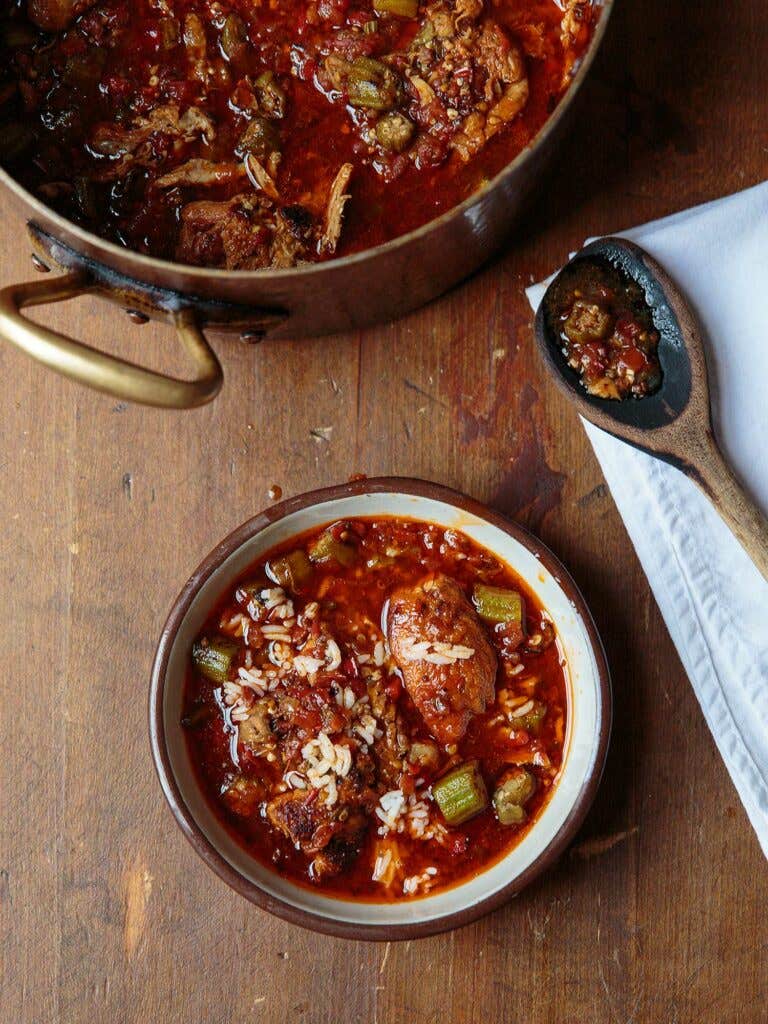
"I use oxtail," Barbara Sias, a cook at the Rice Palace in Crowley, Louisiana, tells me, proving that the proteins in gumbo can vary wildly, too. Indulging my curiosity, she offers me her recipe for oxtail and turkey neck gumbo. Cooking it back home in New York, I find the dish deliciously dangerous in its intensity—the stiff drink of gumbos.
Just as there are many ways to make a gumbo, there are many ways to devour one. It's something I discover at Prejean's in Lafayette, where a young waitress named Kyrie hands me a complimentary demitasse of mustardy potato salad after watching me enjoy my duck and andouille gumbo without it for longer than she can stand. “This is how we eat it here,” she tells me. Adding potato salad to gumbo is a deranged act that pays off in spades. Doing so cools the gumbo down to room temperature and adds a creaminess—a texture sort of like melting ice cream. It's just another example of how far afield this homegrown dish can take you.
On my last day in Louisiana, I find myself in Donald Link's New Orleans kitchen. Photographer Chris Granger has scored us an invite to the chef's house so I can watch him make the same fried chicken and andouille gumbo I made for that Super Bowl party five years ago. Link owns several New Orleans restaurants, including the Cajun-inspired Cochon and the white-tablecloth Herbsaint. I've met him a few times before. He's a big guy. Quiet. And since his mind is pretty much unreadable, he has always intimidated me. Does he like me? I don't know. I like him. His gumbo practically saved my life.

When we arrive that afternoon, he is already adding flour to the sizzling chicken-skin-speckled oil to make his roux. As Link cooks, Granger and I sit at the table drinking what will turn out to be far too many glasses of wine. After a few hours, Link ladles the gumbo into bowls and sprinkles on some rice (down here, rice is a garnish for gumbo, not a base). Devouring it, I am reminded of days gone by, both good times and bad. Afterward, we all go out back for a swim. We toss a football with the chef's son, Nico. We drink more wine. All the while, Granger and I keep disappearing into the kitchen, spooning up more gumbo until the pot is empty, which is a shame since gumbo's always better the next day, or the day after that. As a pink sky gives way to blue darkness, I start feeling some remorse for ever having left this place. It's like Tommy Hebert told me back in Scott: “It's all right here.”
Keep Reading
Continue to Next Story









